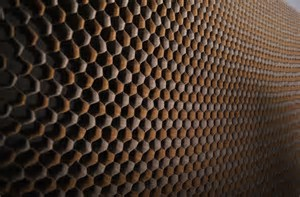
During the Second World War, paper honeycomb was introduced for the airplane industry (fuel tanks for Dakotas). After the war ended paper honeycomb was used primarily as a structural material in the reconstruction of Europe. The shortage of building material (wood, bricks, etc.) made paper honeycomb an excellent cost-effective available alternative. The development of paper honeycomb in North America was based on those post-war European applications.
Paper honeycomb is still used in structural applications such as inner doors, separation walls and furniture (kitchen cabinets). Door companies incorporated high-speed production lines with continuous paper honeycomb and are able to produce up to 10,000 doors a week. In Switzerland and Germany, paper honeycomb has become an important material in home construction. The use of paper honeycomb as a cost-effective way to provide temporary housing units has been explored but despite high interest levels has not become the standard for temporary shelter.
Paper honeycomb is also used as a packaging material. Glued with paper on both sides, it makes an excellent protecting material for all types of items. It is currently used in the following industries: paper, automotive, glass, ceramic, transportation, appliance, and furniture. Paper honeycomb can be die cut, slit scored or cookie cut into numerous sizes and shapes to protect products "inside the box" or "outside the box". Paper honeycomb is a protective packaging alternative to wood, corrugated or EPS.
Paper honeycomb is now being used in transportation applications such as rail car and truck dunnage.